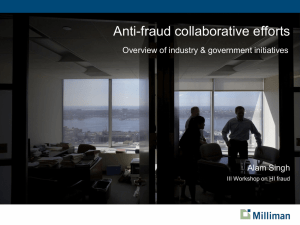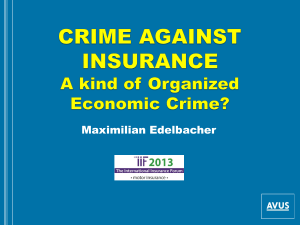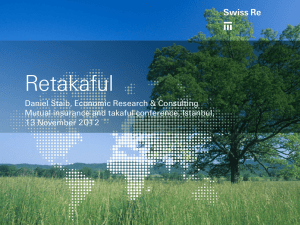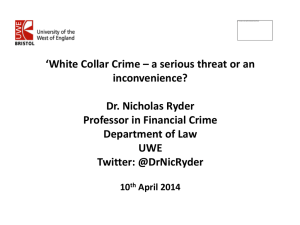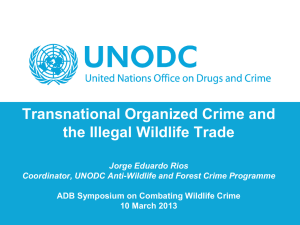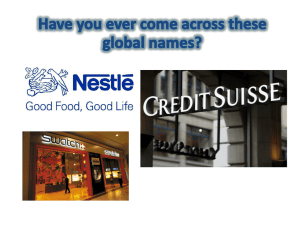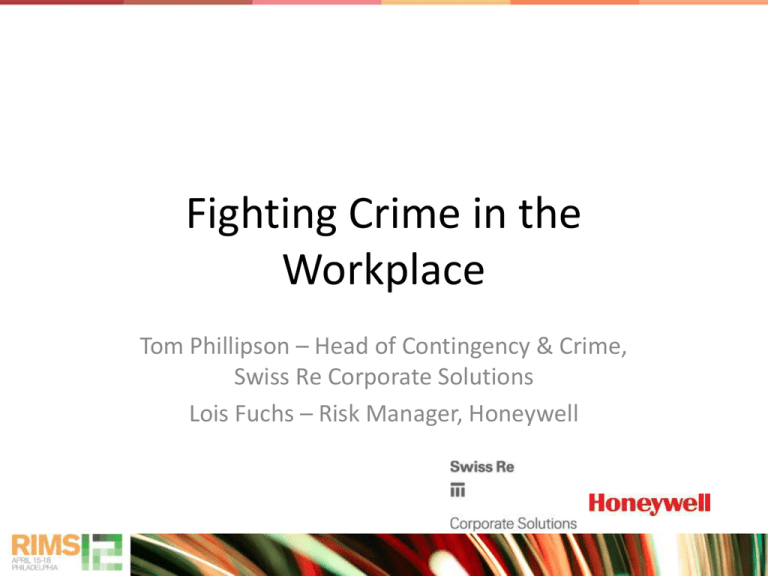
Fighting Crime in the
Workplace
Tom Phillipson – Head of Contingency & Crime,
Swiss Re Corporate Solutions
Lois Fuchs – Risk Manager, Honeywell
Aims & Agenda
Aims
Understanding the prevalence of crime in the workplace
What can YOU do to mitigate this exposure?
Agenda
Industry Statistics
Common Scenarios
Real Losses
Profile of a Perpetrator
Prevention and Detection – a Risk Manager's Perspective (Lois Fuchs)
Commercial Fidelity Insurance
Questions
Crime Exposures
• Cost to industry: typical organisation loses 5% of annual revenue to fraud:
global estimated USD2.9 trillion per annum
• Recession fuelling rise in crime: loss as a proportion of income has risen
20% in the last year
• Severity: approximately 25% of all reported losses cost US companies
more than USD1million
• Difficult to detect: average length of fraud losses prior to detection is 24
months
• Time served: largest frauds are committed by longest serving employees
Common Scenarios
• Theft (by employees or third parties): cash / stock
• Billing: employee creates a fictional vendor and bills employer for nonexistent services
• Bribery and corruption: employee processes inflated invoices for supplier
and takes a kickback
• Premises and transit: robbery/burglary/hold-up
• Payroll: employee claims overtime for un-worked hours or adds ghost
employees to the payroll
• Information: employee or third party steals confidential customer or
product information
Real Losses
• Case Study 1: Milton Morris, senior manager in charge of trucking at SC
Johnson conspires with suppliers to overpay them in return for backhanders. Scam goes undetected for 10 years. Company obtains judgement
against the perpetrator and trucking companies in excess of USD 200m.
• Case Study 2: Chia Teck Leng was sentenced to 42 years in jail, one of the
longest jail term meted out for the largest case in commercial fraud in Asia
to date. Chia was a finance manager at Asia Pacific Breweries when he
forged documents to swindle banks out of S$117 million over four years to
feed his gambling addiction.
• Case Study 3: Singapore Airlines' employee Teo Cheng Kiat, who
embezzled S$35 million from the airline over 13 years. He was convicted in
2000 and jailed for 24 years for the crime.
Profile of a Perpetrator
•
•
•
•
•
•
Age/seniority: middle management aged 41-50 commit more than a third of internal
frauds – more authority and more access to company resources. Also responsible for
the largest losses
Tenure: longer-term employees commit the largest frauds
Department: accounting department employees commit disproportionate number of
crimes (30%). Senior management (18%), operations (16%) and sales (11%) staff also
feature strongly
Background: 87% or perpetrators have never been charged or convicted and 82% have
never previously been punished or terminated
Motivation: domestic financial difficulties/stress including divorce, gambling, drugs.
Pure jealousy combined with rationalisation ("I work just as hard as the CEO why
shouldn't I have the benefits which he/she enjoys"?)
Red flags: living beyond means, financial difficulties, divorce/family problems, close
association with vendor, refusal to take vacation, complains about lack of pay
Prevention and Detection –
A Risk Manager's Perspective
Prevention
• Internal/external audit
• Anti-fraud training
• Dual controls for cheque
signing/wire transfers
• Employee vetting
Detection
• Tip or complaint (including
whistleblower hotline)
• Surprise audit
• Linguistic software
• Red flags
Commercial Fidelity Insurance
Covered
Indemnifies the insured for direct financial loss i.e. first party loss caused by:
• Employee dishonesty
• Theft by a third party
• Counterfeiting or forgery of a negotiable instrument by a third party
• Computer crime by a third party
• Trigger: losses discovered during the policy period.
Commercial Fidelity Insurance
Not Covered
•
•
•
•
•
•
Unauthorised trading
Liabilities to third parties
Loss caused by directors or major shareholders
Consequential loss (e.g. computer downtime)
Pure inventory loss
Theft of trade secrets or confidential information
Questions?
Appendix I – Sources and
Recommended Reading
• Association of Certified Fraud Examiners Global Report 2010
• Kroll Global Fraud Report 2011/12
• PWC Global Economic Crime Survey 2011
Appendix II - Swiss Re Corporate
Solutions Underwriting Appetite
• Target clients: all industry segments, except jeweller’s block & casinos
• Multi-year capabilities
• Capacity & attachment linked to size of insured
Required Underwriting
Information:
– Revenue > USD 500m
• Capacity: up to USD 25m
Number of employees
and their locations
• Attachment point: minimum USD 5m
- Audits
- Training
– Revenue < USD 500m
- Dual controls
(5) year loss history
• Capacity: up to USD 10m
• Attachment point: minimum USD 25k
Thank you!
Legal notice
• ©2012 Swiss Re. All rights reserved. You are not permitted to create any
modifications or derivatives of this presentation or to use it for
commercial or other public purposes without the prior written permission
of Swiss Re.
• Although all the information used was taken from reliable sources, Swiss
Re does not accept any responsibility for the accuracy or
comprehensiveness of the details given. All liability for the accuracy and
completeness thereof or for any damage resulting from the use of the
information contained in this presentation is expressly excluded. Under no
circumstances shall Swiss Re or its Group companies be liable for any
financial and/or consequential loss relating to this presentation.




